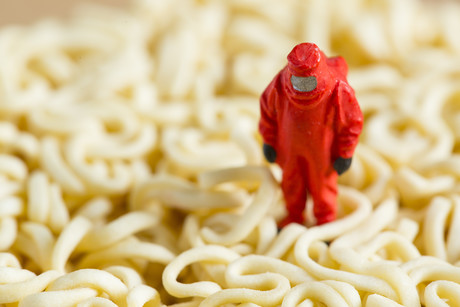Toxins, carcinogens and opportunistic pathogens

There is risk in nearly everything we eat. Risk assessment can be a useful tool for determining the actual threat to human health with numerous variables between population groups and degrees of uncertainty.
Many of the substances that humans consume on a regular basis as part of their basic diet actually contain harmful toxins. Rice, barbecued meat and drinking water all pose threats to human health as hosts to potent toxins, carcinogens and opportunistic pathogens. In many cases, the rise in concentrations of these harmful substances is a direct result of human activity, such as the use of pesticides in crops and even advances in green technology.
Would you like arsenic with your rice?
Really, you don’t have much of a choice. As a result of human activities, arsenic pollution is rising and high levels of inorganic arsenic can be found in all types of rice. Rice is now the single biggest food source of inorganic arsenic, the more toxic form which can be readily absorbed by the gastrointestinal tract. While the toxic symptoms generally take a long time to develop, long-term ingestion, particularly for people with rice-based diets, can result in various health problems, including cancer, heart disease and decreased intelligence.
Zheng Zhou, MPH, Indiana University, performed a systematic review to summarise the current state of knowledge on the bio-accessibility of arsenic in rice and a meta-analysis to provide a more robust probabilistic estimation. Zhou analysed 143 articles from PubMed and Toxline online databases and the meta-analysis showed that the median bio-accessibility estimate was 73.1% and 88.6% for total and inorganic arsenic, respectively, revealing that a majority of the arsenic found in rice is being absorbed into the consumer’s system, where it can build up over time.
How about some polycyclic aromatic hydrocarbons with your steak?
Heat-processed meat may contain high concentrations of polycyclic aromatic hydrocarbons, a class of chemical components, including benzo[a]pyrene (BaP), classified as a group 1 human carcinogen by the International Agency for Research on Cancer. To minimise risk from dietary exposure, food and health authorities may advise to limit certain meat preparation practices such as barbecuing. Stylianos Georgiadis, Technical University of Denmark, and his team of researchers sought to estimate the extra lifetime risk of cancer due to exposure to BaP through barbecued meat.
The study, ‘Risk assessment of benzo[a]pyrene in heat-processed meat in Denmark: A probabilistic approach’, will help risk managers and policymakers properly evaluate and communicate the cancer risk associated with heat-processed meat consumption, accounting for population variability and associated uncertainties.
The downside of water efficiency — it may be making you sick
Green building practices and design elements focused on the efficient use of water and energy, such as low-flow fixtures and high-efficiency appliances, continue to gain popularity. The percentage of US homes with an average toilet flush volume of less than 7.5 L has increased from 8.5% in 1999 to 37% in 2016. Adoption of these technologies has drastically reduced water consumption in the US; however, plumbing system design has not adequately kept pace. The result has been an increase in hydraulic retention time, or ‘water age’ which can adversely affect water quality.
With increased water age comes a reduction of disinfectant residual, increased leaching of pipe materials into the bulk water and the promotion of opportunistic pathogens such as Legionella spp., Mycobacterium spp. and P. aeruginosa, and are the primary cause of waterborne disease in developed countries. Ryan Julien, PE, Michigan State, conducted a study aimed at estimating water age within premise plumbing of a full-scale residential net-zero building to evaluate health risks. Julien’s study, ‘Estimating water age and its effects on water quality in a full-scale green home’, reviews multiple flow regimes to estimate water age during use and compare these results to measured water quality in the home.
Maybe give up drinking from your private well
Lead exposure is still a prominent concern in many communities, and there is no safe level of exposure. To better understand the relationship between lead exposure in drinking water from private wells and human health outcomes, Abhishek Komandur, University of North Carolina at Chapel Hill, conducted a study — ‘Determining the relationship between drinking private well water and children’s blood lead levels’. Private drinking wells are not covered by the Safe Drinking Water Act and many individuals do not test their wells for lead and other contaminants.
Komandur used regression models to explore the relationship between water lead and blood lead in 60 children under the age of seven in North Carolina. “We hope the results from this research will encourage more people to test water from their private wells,” Komandur said. “We also hope that it will provide more evidence to connect households to a municipal water supply.”
These topics were all covered at the 2018 Society for Risk Analysis (SRA) Annual Meeting at the New Orleans Marriott in New Orleans, Louisiana.
Finding ways to preserve food quality and ensure food safety
A US study has developed a framework for food processors to preserve quality and maintain food...
Salty snack study: does size matter?
Food scientists have suggested that the size of individual salty snacks could have an effect on...
Meaty mould: could it be the smart food of the future?
While a mould patty burger doesn't sound too appetising, fungi is being explored as a...












